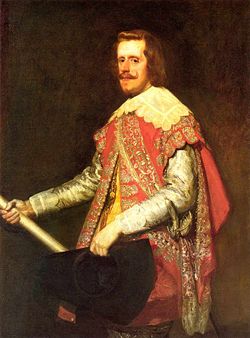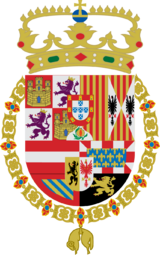Philip IV of Spain
| Philip IV | |
|---|---|
| King of Spain and Portugal (more...) | |
 |
|
| King of Spain (more...) | |
| Reign | March 31, 1621-September 17, 1665 |
| Predecessor | Philip III |
| Successor | Charles II |
| King of Portugal (more...) | |
| Reign | March 31, 1621-December 1, 1640 |
| Predecessor | Philip II |
| Successor | John IV |
| Consort | Elisabeth of Bourbon Mariana of Austria |
| Issue | |
| Baltasar Carlos, Prince of the Asturias María Teresa, Queen of France Margaret Theresa, Holy Roman Empress Philip Prospero, Prince of Asturias Charles II John of Austria the Younger |
|
| Father | Philip III of Spain |
| Mother | Margaret of Austria |
| Born | April 8, 1605 Valladolid, Spain |
| Died | September 17, 1665 (aged 60) Madrid, Spain |
Philip IV (Felipe IV, Filipe III), (8 April, 1605 – 17 September, 1665) was King of Spain between 1621 and 1665, sovereign of the Spanish Netherlands, and King of Portugal until 1640. On the eve of his death in 1665, the Spanish empire reached its historical zenith spanning almost 3 billion acres.
Philip IV was born in Valladolid, and was the eldest son of Philip III and his wife Margaret of Austria.
Contents |
Life
Philip IV's reign, after a few years of inconclusive successes, was characterized by political and military decay and adversity. He has been held responsible for the decline of Spain, which was mostly due, however, to organic causes largely beyond the control of any one ruler. Philip certainly possessed more energy, both mental and physical, than his diffident father. His handwritten translation of Francesco Guicciardini's texts on political history still exists, and he was a fine horseman and keen hunter.
His artistic taste is shown by his patronage of his court painter Diego Velázquez; his love of letters by his favoring Lope de Vega, Pedro Calderón de la Barca, and other immortal dramatists. He is credited, on fairly probable testimony, with a share in the composition of several comedies. He also commenced the building of the Buen Retiro palace in Madrid, parts of which still remain near the Prado.

His good intentions were no avail to governance, however. Feeling himself not yet qualified to rule when he ascended to the throne at age 16, he allowed himself to be guided by the most capable men he could find. His favourite, Olivares, was a far more honest and capable man than his predecessor the Duke of Lerma, and better fitted for the office of chief minister than any Spaniard of the time, perhaps. Philip, however, lacked the confidence to free himself from Olivares's influence once he did come of age. With Olivares's encouragement, he rather busied himself with frivolous amusements.
In December 1st, 1640, a uprising took place in Lisbon expelling King Philip IV of Spain (Philip III of Portugal) from the Portuguese throne, giving it to the Braganzas. This was the end of 60 years of the Iberian Union and the beginning of the Portuguese Restoration War (lost by the Habsburgs).
By 1643, when disasters falling on all sides led to the dismissal of the all-powerful minister, Philip had largely lost the power to devote himself to hard work. After a brief struggle with the task of directing the administration of the most extensive and worst-organized multi-national state in Europe, he sank back into indolence and let other favourites govern.
His political opinions were those he had inherited from his father and grandfather. He thought it his duty to support the House of Habsburg and the cause of the Roman Catholic Church against the Protestants, to assert his sovereignty over the Dutch, and to extend the dominions of his family. The utter exhaustion of his people in the course of perpetual war, against the Netherlands, France, Portugal, Protestant forces in the Holy Roman Empire and Great Britain, was seen by him with sympathy but he considered it an unavoidable misfortune, since he could not have been expected to renounce his legitimate rights, or to desert what he viewed as the cause of God, the Church and the House of Habsburg.
He was idealised by his contemporaries as the model of Baroque kingship. Outwardly he maintained a bearing of rigid solemnity, and was seen to laugh only three times in the course of his entire public life. But, in private, his court was grossly corrupt. Victorian historians prudishly attributed the early death of his eldest son, Baltasar Carlos, to debauchery, encouraged by the gentlemen entrusted by the king with his education. This shocked the king, but its effect soon wore off. Philip IV died broken-hearted in 1665, expressing the pious hope that his surviving son, Carlos, would be more fortunate than himself. On his death, a catafalque was built in Rome to commemorate his life.
Ancestors
|
||||||||||||||||||||||||||||||
| Philip IV of Spain, III of Portugal | Father: Philip III of Spain, II of Portugal |
Father's father: Philip II of Spain, I of Portugal |
Father's father's father: Charles V, Holy Roman Emperor |
| Father's father's mother: Isabella of Portugal |
|||
| Father's mother: Anna of Austria |
Father's mother's father: Maximilian II, Holy Roman Emperor |
||
| Father's mother's mother: Maria of Spain |
|||
| Mother: Margaret of Austria |
Mother's father: Charles II, Archduke of Austria |
Mother's father's father: Ferdinand I, Holy Roman Emperor |
|
| Mother's father's mother: Anna of Bohemia and Hungary |
|||
| Mother's mother: Maria Anna of Bavaria |
Mother's mother's father: Albert V, Duke of Bavaria |
||
| Mother's mother's mother: Anna of Austria |
Family
Siblings
- Anne of Austria (1601–1666), who became Queen of France;
- Maria Anna of Spain (1606–1646), who became Holy Roman Empress;
- Ferdinand, who became Governor of the Habsburg Netherlands
Children
With Elisabeth of Bourbon (1603–1644, daughter of Henry IV of France) — married 1615 at Burgos
- Infanta Maria Margaret (Maria Margarita) (1621)
- Infanta Margaret Maria Catherine (Margarita Maria Catalina) (1623)
- Infanta Maria Eugenia (1625–1627)
- Infanta Isabella Maria Theresa (Isabel Maria Teresa) (1627)
- Baltasar Carlos, Prince of the Asturias (1629–1646)
- Infanta Maria Anna Antonia (Mariana or Maria Ana Antonia) (1636)
- Maria Theresa of Spain (1638–1683), queen consort of France as first wife of Louis XIV of France
With Mariana of Austria (1634–1696) - his niece - — in 1649
- Margaret of Spain (July 12, 1651 – 12 March 1673), first wife of Leopold I, Holy Roman Emperor
- Infanta Maria Ambrosia de la Concepción (1655)
- Philip Prospero of Spain (1657–1661).
- Infante Thomas Charles (Tomas Carlos) (1658–1659)
- Charles II of Spain (1661–1700)
With Maria Calderon{a}
- John of Austria the Younger {1629 – 1679}
In fiction
- The novel The king Amaz'd by the Spanish novelist Gonzalo Torrente Ballester is an ironic portrait of the early years of Philip IV's reign. The movie El rey pasmado, based on the novel, was directed by Imanol Uribe and features Gabino Diego as Philip in his early reign.
- Spanish author Arturo Pérez-Reverte gives an exquisite description of the difficult social, political and military conditions during the reign of Philip IV in his series of bestselling novels starring the swashbuckler Captain Alatriste.
- The children's novel I, Juan de Pareja (a Newbery award winner by Elizabeth Borton de Trevino) chronicles, in part, the period of painter Diego Velazquez's life spent in Philip IV's court as court painter. Philip IV is portrayed as sensitive, shy, and kind-hearted.
References
This article incorporates text from the Encyclopædia Britannica Eleventh Edition, a publication now in the public domain.
|
Philip IV of Spain
Born: 8 April 1605 Died: 17 September 1665 |
||
| Regnal titles | ||
|---|---|---|
| Preceded by Philip III of Spain II of Portugal |
King of Portugal and the Algarves 31 March 1621 –1 December 1640 |
Succeeded by John IV |
| King of Spain 31 March 1621– 17 September 1665 |
Succeeded by Charles II as King of Spain and ruler of the Spanish Netherlands |
|
| Preceded by Archduke Albert of Austria and Infanta Isabella of Spain |
Ruler of the Spanish Netherlands Losing Artois and parts of Flanders and Luxembourg to France in 1659 31 July 1621-17 September 1665 |
|
| Italian nobility | ||
| Preceded by Isabella Appiani |
Prince of Piombino 1628 – 1634 |
Succeeded by Niccolò I Ludovisi |
| Spanish royalty | ||
| Preceded by Philip III |
Prince of Asturias 1605 – 1621 |
Succeeded by Balthasar Charles |
| Portuguese royalty | ||
| Preceded by Anne |
Prince of Portugal 1605 – 1621 |
Succeeded by Balthasar Charles |
|
||||||||||||||||||||||||||
|
||||||||||||||||||||
